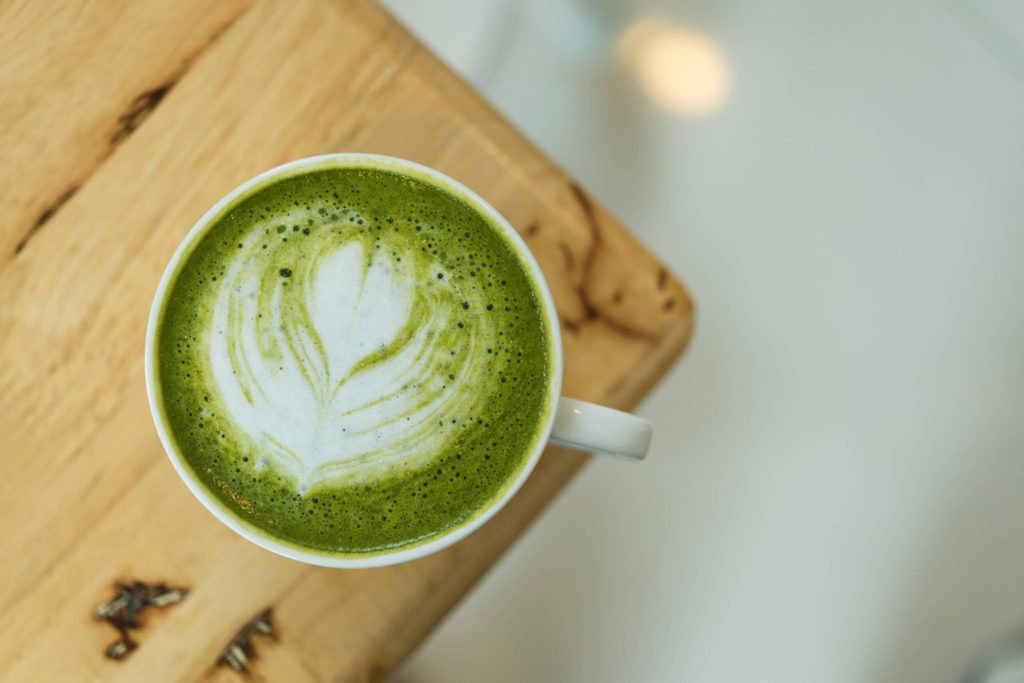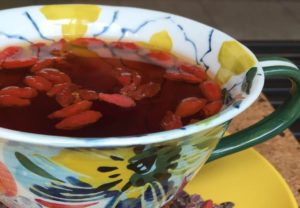Matcha – the finely ground powder of shade-grown green tea leaves–is a longtime favorite among meditators and yoga practitioners, for the ways in which it clarifies the mind at the same time as it calms the nervous system. What accounts for these seemingly paradoxical effects? And what’s the historical origin of this elegant drink? Let’s begin with the latter question …

A BRIEF HISTORY OF MATCHA
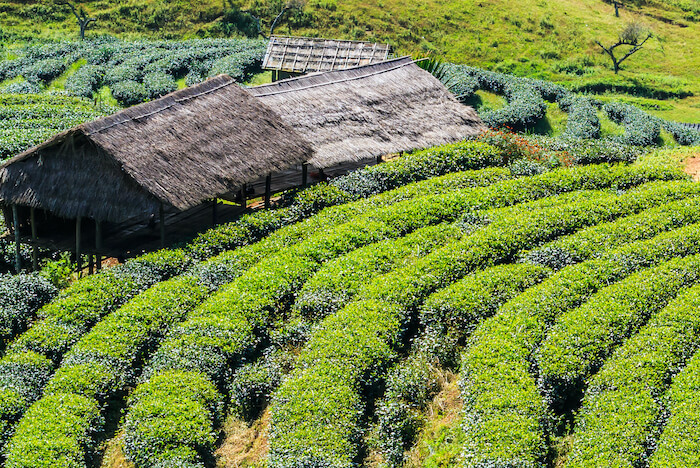
Though the tea plant itself–Camellia Sinensis is its Latin name–is a shrub that’s native to Southern China, matcha has its historical origins in Japan. A Zen Monk by the name of Eisai is said to have brought the first green tea seeds from China to Japan just over 800 years ago, in 1191 A.D. He planted these seeds on the grounds of a Zen temple in Kyoto. No one knows what first inspired him to grind the green tea leaves, rather than steeping them, but that’s what happened, to give birth to the drink we now call matcha.
The Japanese word “cha” translates into English as “tea;” and the Japanese word “ma” means “powder”–so the literal translation of matcha is tea powder. The Japanese word “cha” also features in chado: the Japanese tea ceremony. The “do” part of chado translates as “way”–and the tea ceremony is known also as “the way of tea.” While matcha is not the only type of tea used in Japanese tea ceremonies, it is a very common choice.
The four basic principles embodied in the Japanese Tea Ceremony are: (1) Harmony (wa); (2) Respect (kei); (3) Purity (sei); and (4) Tranquility (jaku). And, as we’ll see below, the unique qualities of matcha make it a perfect choice for representing these principles.
WHAT MAKES IT SPECIAL
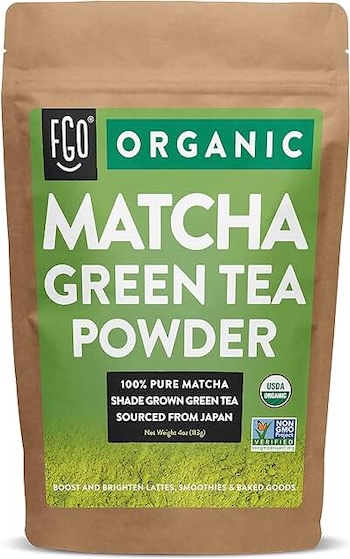
FGO Organic Matcha Green Tea Powder, Japanese Culinary Grade
The specialness of this green tea begins with the specific environment in which the tea bushes are grown. The bushes are grown in nearly complete shade, which greatly increases the chlorophyll content of the leaves. It also increases also their level of L-Theanine: an amino acid that stimulates the production of alpha waves in the brain (which are associated with a state of relaxed alertness).
The unique chemical composition of the tea leaves used to make matcha means that the caffeine is assimilated into our body in a way that provides three to four hours of sustained energy and mental brightness–rather than the “spike and crash” typical of coffee or black tea.
This combination of “time-released” caffeine with the alpha-wave-producing L-Theanine creates a state of relaxed and calm mental clarity and brightness, which is exactly the state of mind that meditators seek to cultivate. This makes matcha is a wonderful support for meditation or yoga practice, or any other activity that benefits from having us awake and energized, while at the same time calmly focused.
WHAT TO LOOK FOR IN A GOOD MATCHA
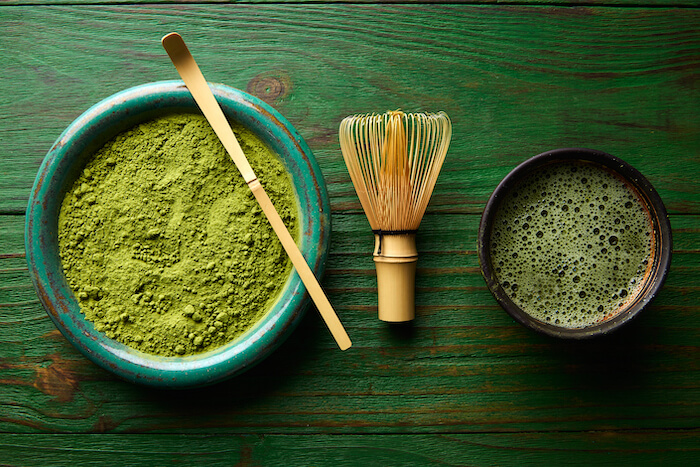
There are various grades of matcha. The “ceremonial” grade is the highest, and will offer the best-tasting matcha. A “food grade” matcha is typically a bit more bitter in taste, but still can be excellent for including in smoothies or baked goods. Generally speaking, a high-quality matcha will be a bright (almost neon) green; its bitterness will be tempered by an almost-sweet smoothness, and it will froth generously when you whisk it.
If it’s your intention to purchase authentic matcha, then you’ll want to avoid what is often labeled simply as “green tea powder.” Matcha is made from the buds and top leaves of shade-grown tea bushes, and ground in a way that fully preserves fully their rich nutrients. Green tea powder, on the other hand, is simply the dried, powdered leaves and stems of typical green tea: a substance which tends to be much more bitter than matcha, and not nearly as nutritionally beneficial.
You can, of course, do your own research, and find a brand that suits your own needs and taste buds. That said, some excellent ones to consider are: DoMatcha and ZenMatcha and Rishi Tea Matcha Super Green which all are of excellent quality.
HOW TO MAKE MATCHA TEA
To make your matcha into an elegant and delicious drink, place a small amount of water in the bottom of a bowl. Add a teaspoon or so of the powder, and stir the water and powder together into a thick paste. Pour hot water over the paste, and use a whisk to create the frothy green drink. Adding a bit of honey and/or cream is a nice option, if you prefer a sweeter taste.
Enjoy!
YOU MAY ALSO LIKE:
BALASANA – CHILD’S POSE: SOOTHE AND RELEASE
Balasana, Child’s Pose, is a restorative pose that can be practiced on its own or as part of a routine. A…
WISDOM & COMPASSION: THE TWO “WINGS” OF YOGA PRACTICE
By Elizabeth Reninger In the same way that a bird requires two wings in order to fly, a human being requires…
CAN CERTAIN HERBS AND SPICES IMPROVE BRAIN FUNCTION?
By Dr. Kristie Leong M.S, M.D The human brain is a complex and fascinating organ. Not surprisingly, there has been much…
10 TOP BENEFITS OF GOJI BERRIES
Goji berries, also known as Wolfberries, Matrimony Vine, or Desert Thorns, have become widely popular nowadays. They are used in various…
8 HOLISTIC HEALTH QUOTES TO INSPIRE YOUR WELLNESS JOURNEY
Staying motivated along your path of wellness journey can be one of your biggest challenges, especially when life’s stresses start adding…
THE MYRIAD JOYS OF KEEPING A JOURNAL
“The moon and sun are eternal travelers. A lifetime adrift in a boat, or in old age leading a tired horse…

